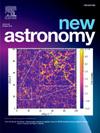朝向IRAS 03523+5343的年轻星团
IF 2.1
4区 物理与天体物理
Q2 ASTRONOMY & ASTROPHYSICS
引用次数: 0
摘要
我们提出了一项恒星形成的研究,发生在(外)星系第二象限的分子云最活跃的区域,朝向IRAS 03523+5343。在Roque de Los Muchachos天文台的北欧光学望远镜上使用NOTCam获得近红外JHKS图像和k波段光谱。还探索了中红外WISE卫星图像和水下JCMT/SCUBA-2目录源。此外,利用叶贝斯40 m望远镜获得了毫米线CS光谱。在我们的CS (J=1−0)地图覆盖的分子云区域内,这条线很强,并且延伸到3.7 ‘ ×3.7 ’的所有映射区域。这种高密度分子气体定义了一个分子核,其角尺寸FWHM约为1 ' (2.4 kpc距离为0.7 pc)。我们估计该区域分子气体质量的下限约为995 M⊙。探测到一个水肺-2核心,估计总质量为250 M⊙。我们确定了一个年轻的星团,它有几百个源,颜色与yso兼容,位于与IRAS位置一致的恒星密度强增强的位置。IRAS源的主要对应物是一个非常红色和明亮的源,有射电喷流,可能是一个大质量的年轻恒星物体。第二个明亮的源是赫比格Be候选源,它显示一个蓝色星云,其形态表明准直流的耗散。本文章由计算机程序翻译,如有差异,请以英文原文为准。
The young stellar cluster towards IRAS 03523+5343
We present a study of the star formation occurring in the most active region of a molecular cloud in the second quadrant of the (outer) Galaxy towards IRAS 03523+5343. Near-infrared images and -band spectroscopy were obtained with NOTCam at the Nordic Optical Telescope at the Roque de Los Muchachos Observatory. Mid-infrared WISE satellite images and submm JCMT/SCUBA-2 catalogue sources were also explored. In addition, millimetre line CS spectra were obtained with the Yebes 40 m telescope.
Within the region of the molecular cloud covered by our CS maps, the line is strong and extends over all the mapped region of . This high-density molecular gas defines a molecular core exhibiting an angular size FWHM of about (0.7 pc at 2.4 kpc distance). We estimate a lower limit to the mass of the molecular gas in this region to be about 995 . A SCUBA-2 core was detected with an estimated total mass of 250 .
We identify a young stellar cluster with a few hundred sources with colours compatible to YSOs at the location of a strong enhancement of the stellar density coincident with the IRAS position. The main counterpart of the IRAS source is a very red and bright source with radio jets likely to be a high-mass young stellar object. A second bright source is a Herbig Be candidate source displaying a blue nebula with a morphology that suggests the dissipation of a collimated flow.
求助全文
通过发布文献求助,成功后即可免费获取论文全文。
去求助
来源期刊

New Astronomy
地学天文-天文与天体物理
CiteScore
4.00
自引率
10.00%
发文量
109
审稿时长
13.6 weeks
期刊介绍:
New Astronomy publishes articles in all fields of astronomy and astrophysics, with a particular focus on computational astronomy: mathematical and astronomy techniques and methodology, simulations, modelling and numerical results and computational techniques in instrumentation.
New Astronomy includes full length research articles and review articles. The journal covers solar, stellar, galactic and extragalactic astronomy and astrophysics. It reports on original research in all wavelength bands, ranging from radio to gamma-ray.
 求助内容:
求助内容: 应助结果提醒方式:
应助结果提醒方式:


